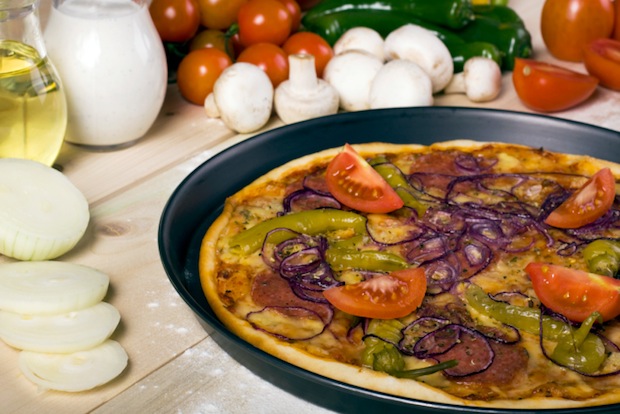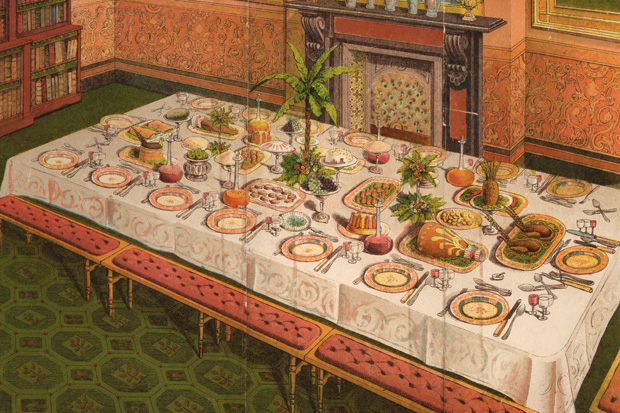Nigel Slater’s books lead the field in cookery book design, but his latest, Eat: The
Little Book of Fast Food (Fourth Estate, £26, Spectator Bookshop, £20), is the most beautiful yet. The size of a large paperback and twice as thick, the single word Eat is embossed in black on a mustard-yellow cloth cover. The book is very easy to use. In the front is a list of recipes, organised by main ingredient; in the back a good index.
The chapters are grouped by cooking method, and the recipes written in shortened form, with ingredients in bold type in the body of the text. Beside many of the recipes a section entitled ‘A Few Thoughts’ gives alternative ways of cooking, or adding to, the dish in question — which expands the recipes until you can no longer count them. You could cook from this book for years, needing no other, and the dishes are so delicious you might not even want another.
Though Slater rhapsodises about a chunky sandwich of roast vegetables and garlic mayonnaise, eaten in the hand, Eat also contains more sophisticated offerings, suitable for dinner parties (remember them?). Well, they are alive and thriving in north London, where James Ramsden runs his supper club, The Secret Larder, feeding 20 people a week in a small coffee shop. His book Do-Ahead Dinners (Pavilion, £20, Spectator Bookshop, £15.50) is about the sort of practical entertaining which leaves the host or hostess able to talk to their guests instead of being stuck red-faced and panicking in the kitchen.
Ramsden’s menus can be prepared well in advance, with a few last-minute twiddles. He makes it all very simple and includeseverything from cocktails and pre-dinner snacks to sweet things to have after pudding. The photography is beautiful, and though he favours casual meals served on scrubbed planks with the roasting tin on the table, his recipes and meal plans will translate to Spectator readers’ mahogany boards and gleaming silver candelabra.
At the other end of the cooking scale is Tim Hayward’s Food DIY: How to Make your Own Everything (Penguin Fig Tree, £25, Spectator Bookshop, £20), which is about preserving and covers the ground fully, from homemade salami and haggis to junket. But it is Hayward’s al fresco cooking which makes his book stand out from others on this fashionable topic. Once he moves out of doors, Hayward becomes the Bear Grylls of cookery. And while he doesn’t actually grill a bear, he does deep-fry a turkey in a large tank of oil, smoke a salmon in an old gym locker and make the smoky pulled pork that was one of the most delicious things I have eaten this year.
Food DIY would be the perfect present for a family with teenage boys, who would love its fire pits, cooking underground and hog roasts — or for anyone who enjoys the deep, succulent meatiness of this kind of cooking. All you need is a gung-ho attitude, a back garden and a fire extinguisher. But I think I will stick to his lovely recipe for crab pasties.
Many of Hayward’s recipes are for dishes (doner kebab, salt beef) that make great snacks to buy and eat on the hoof. Pizza is another, but it hasn’t been possible to make it successfully at home until the publication of Artisan Pizza by Giuseppe Mascoli and Bridget Hugo (Kyle, £12.99, Spectator Bookshop, £10.90), Domestic ovens will not get hot enough to achieve the essential Neopolitan cornicione — a crisp, light crust, textured with air bubbles. Mascoli is the brains behind the pizza chain Franco Manca, and his book explains exactly how to do it: you need an iron pan and a peel — the paddle that bakers use — and careful attention to the making of the dough. There are traditional recipes like Caprese and Margherita, though they look and taste miles better than a high-street takeaway, and a few wilder ones. Smoked ricotta, baked potato and pig’s cheek anyone?
Guiseppe Mascoli was also the ‘father’ of the food writer Rose Prince and her son Jack’s Pocket Bakery (Weidenfeld, £18.99, Spectator Bookshop, £15.99). Three years ago Prince suggested the idea of a bakery, selling bread once a week from their home, to Jack, 14, and his sister Lara, 11, when they said they needed more pocket money. She consulted Mascoli, who brought round a sourdough ‘mother’ that had been in his family since 1790 and showed them how to make artisan bread.
The bakery thrived and has now expanded to a cake and pie business in a student café. Prince gives some of their best recipes — an unsweetened raisin bread, duck-and-pork hand pies (so called because one will fit in the hand) and a fruit pecan macaroon that would make a perfect light Christmas cake.
Got something to add? Join the discussion and comment below.
Get 10 issues for just $10
Subscribe to The Spectator Australia today for the next 10 magazine issues, plus full online access, for just $10.
You might disagree with half of it, but you’ll enjoy reading all of it. Try your first month for free, then just $2 a week for the remainder of your first year.














Comments
Don't miss out
Join the conversation with other Spectator Australia readers. Subscribe to leave a comment.
SUBSCRIBEAlready a subscriber? Log in